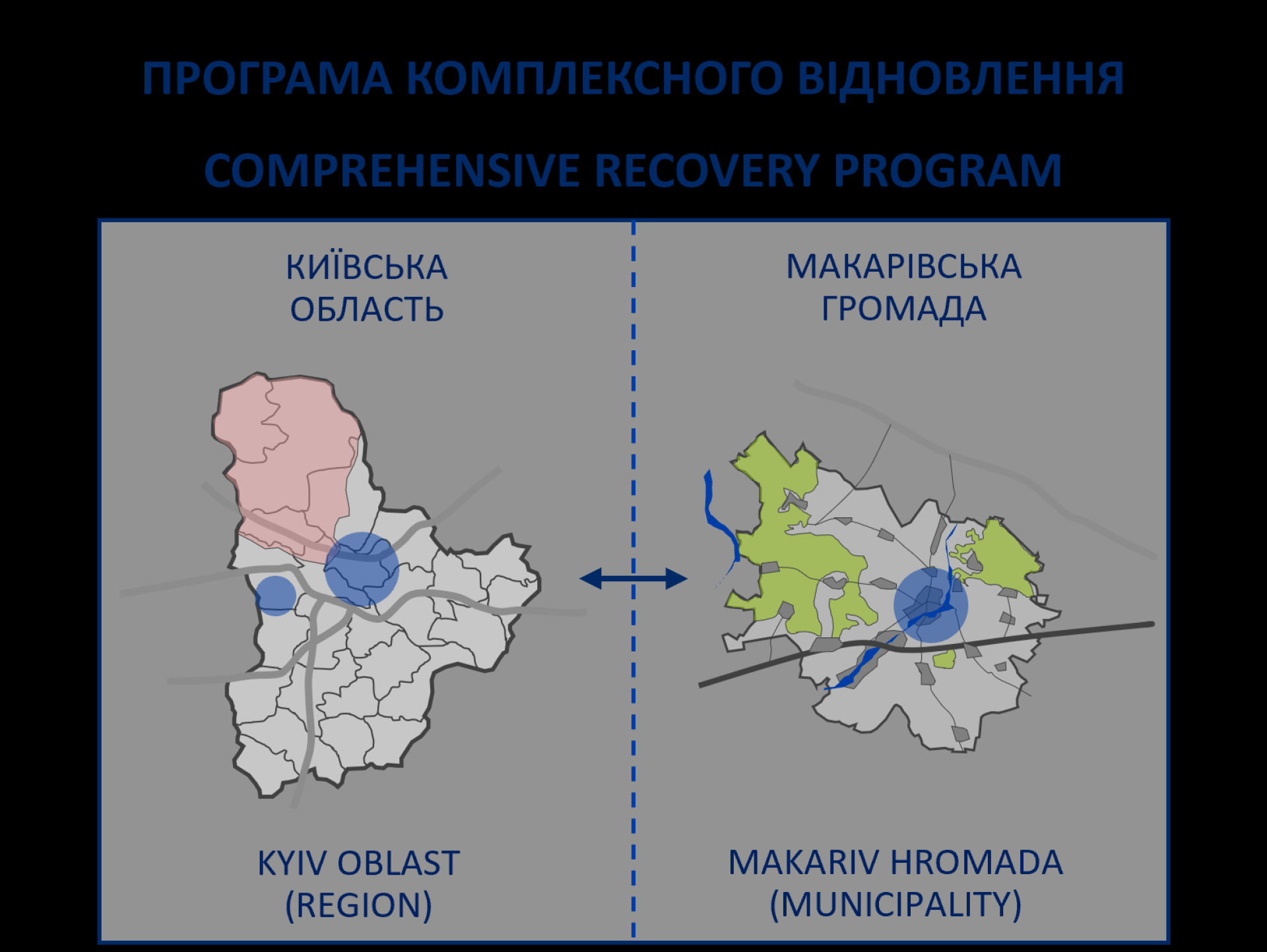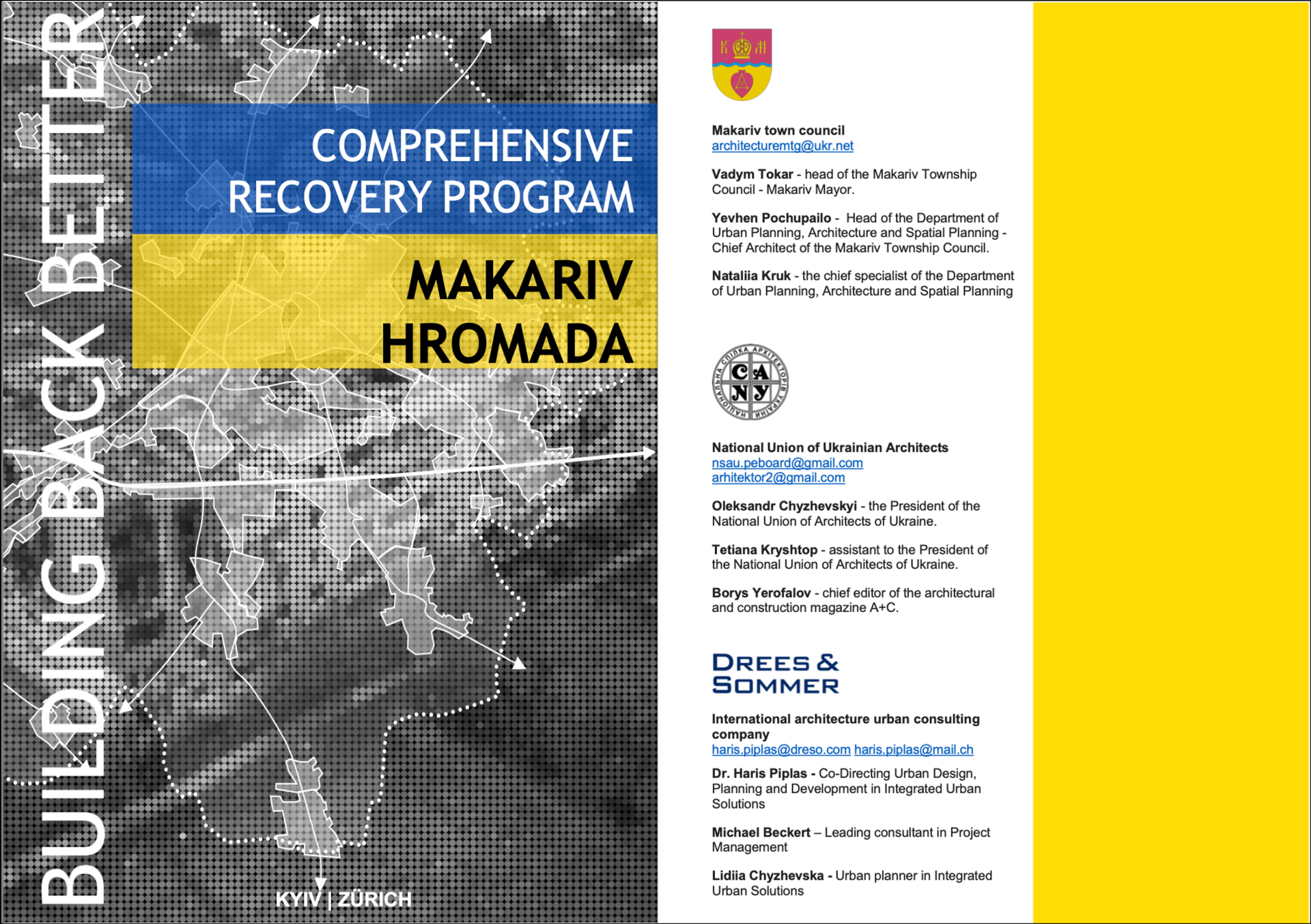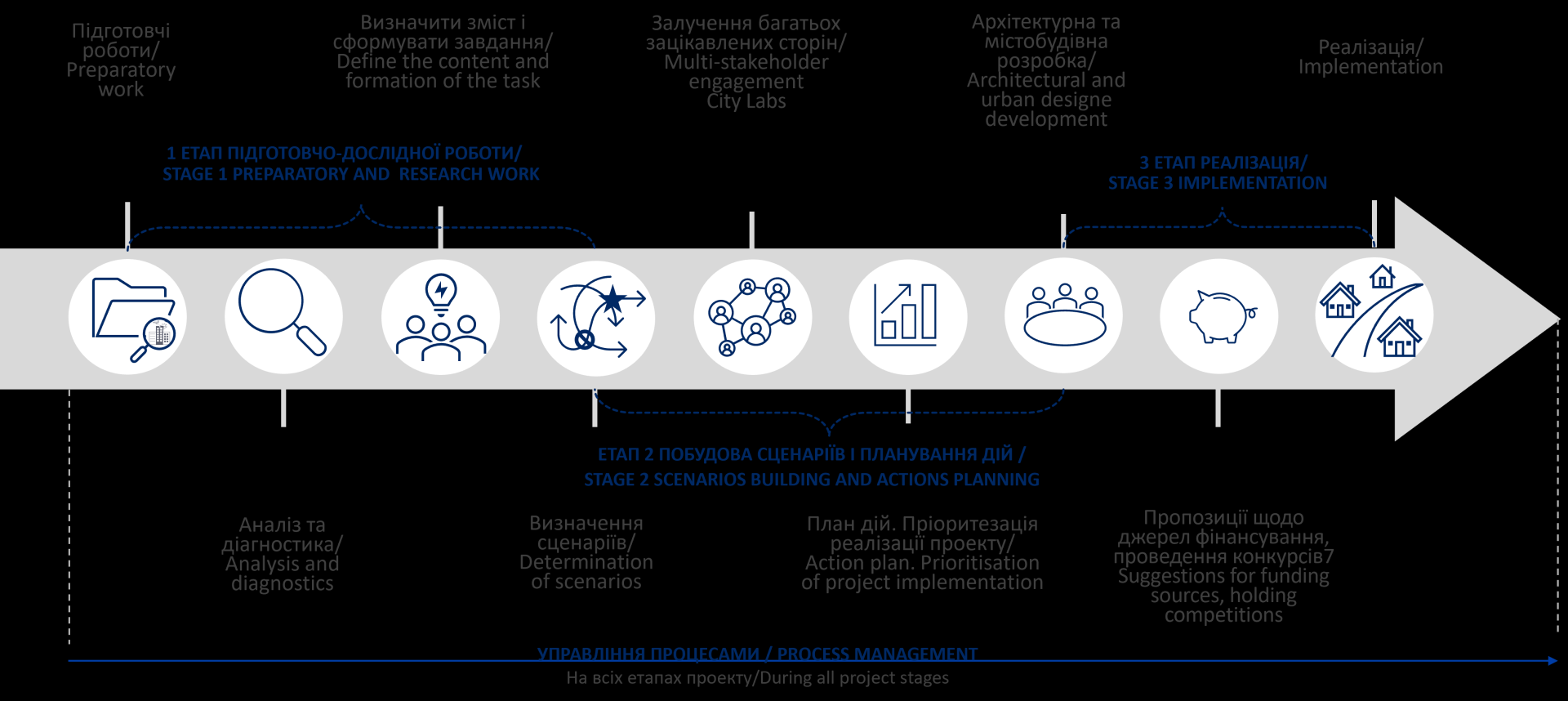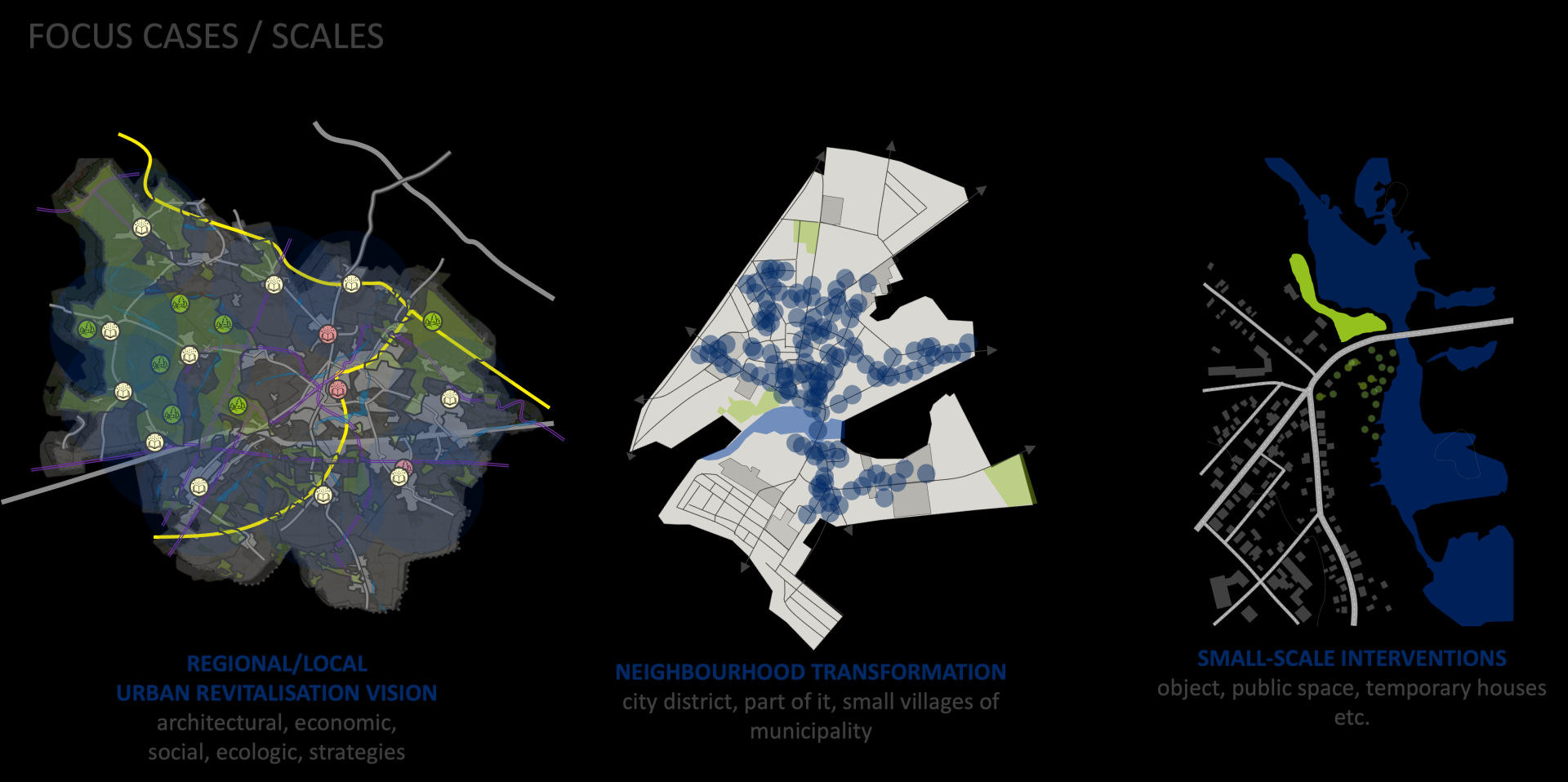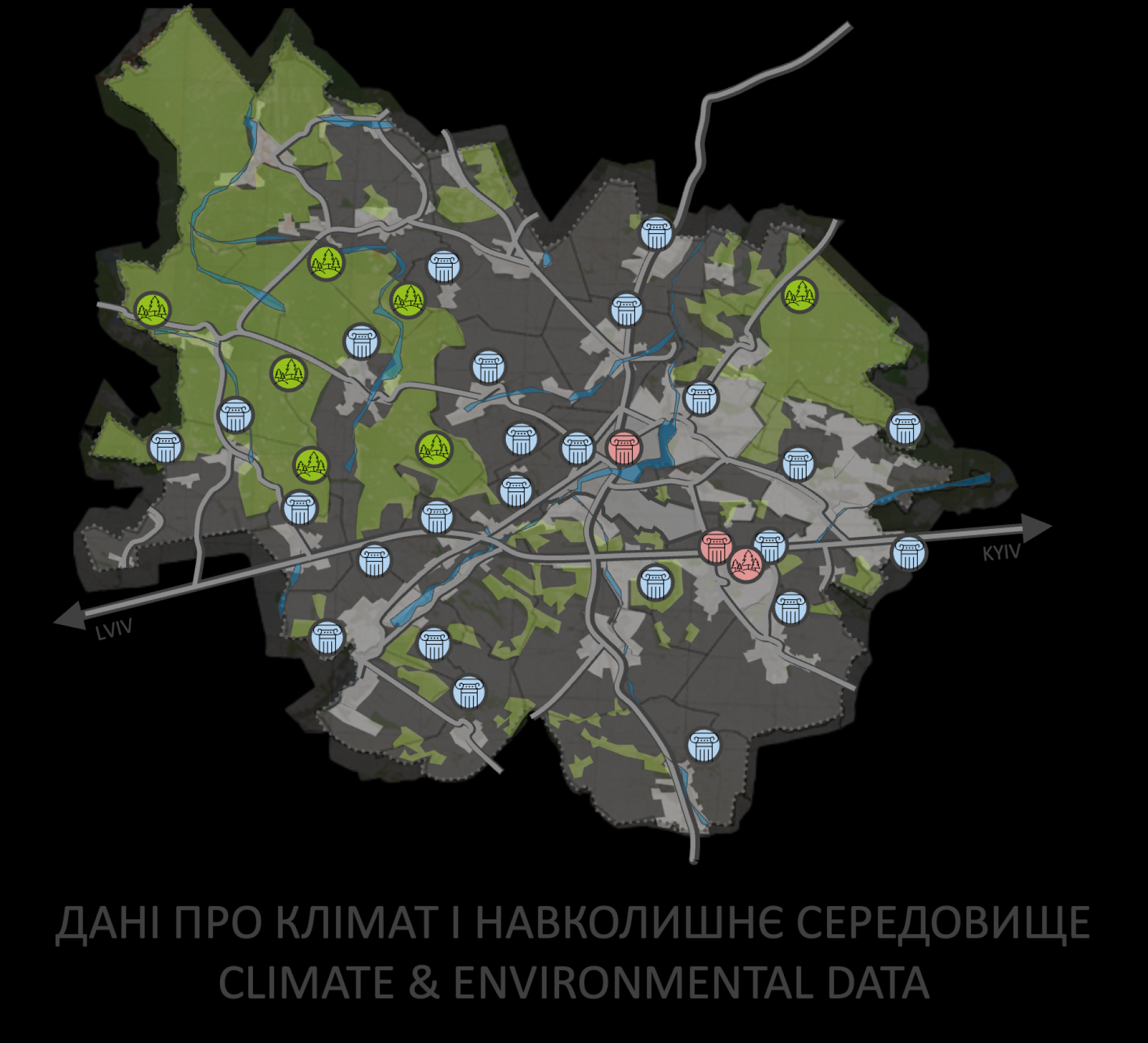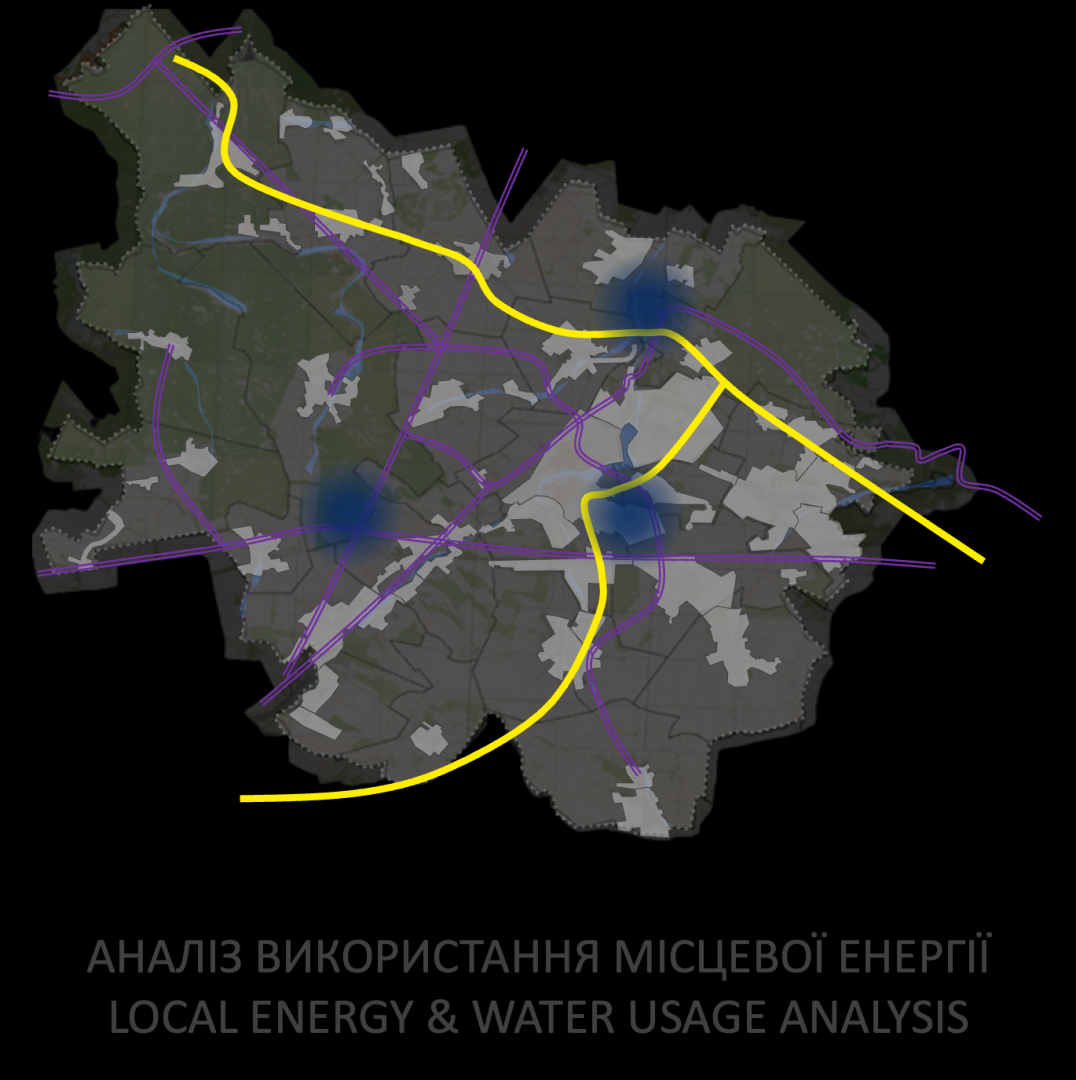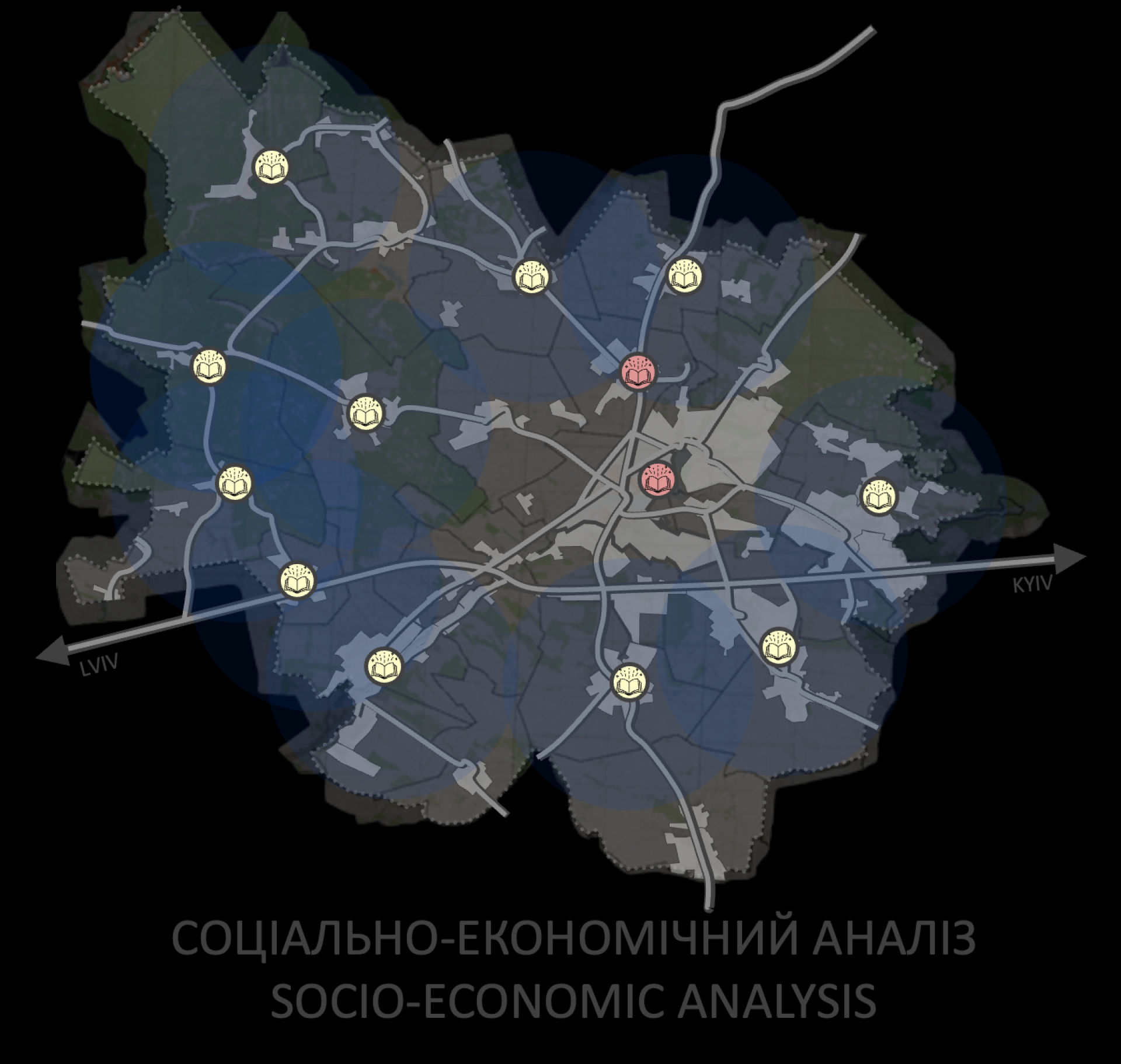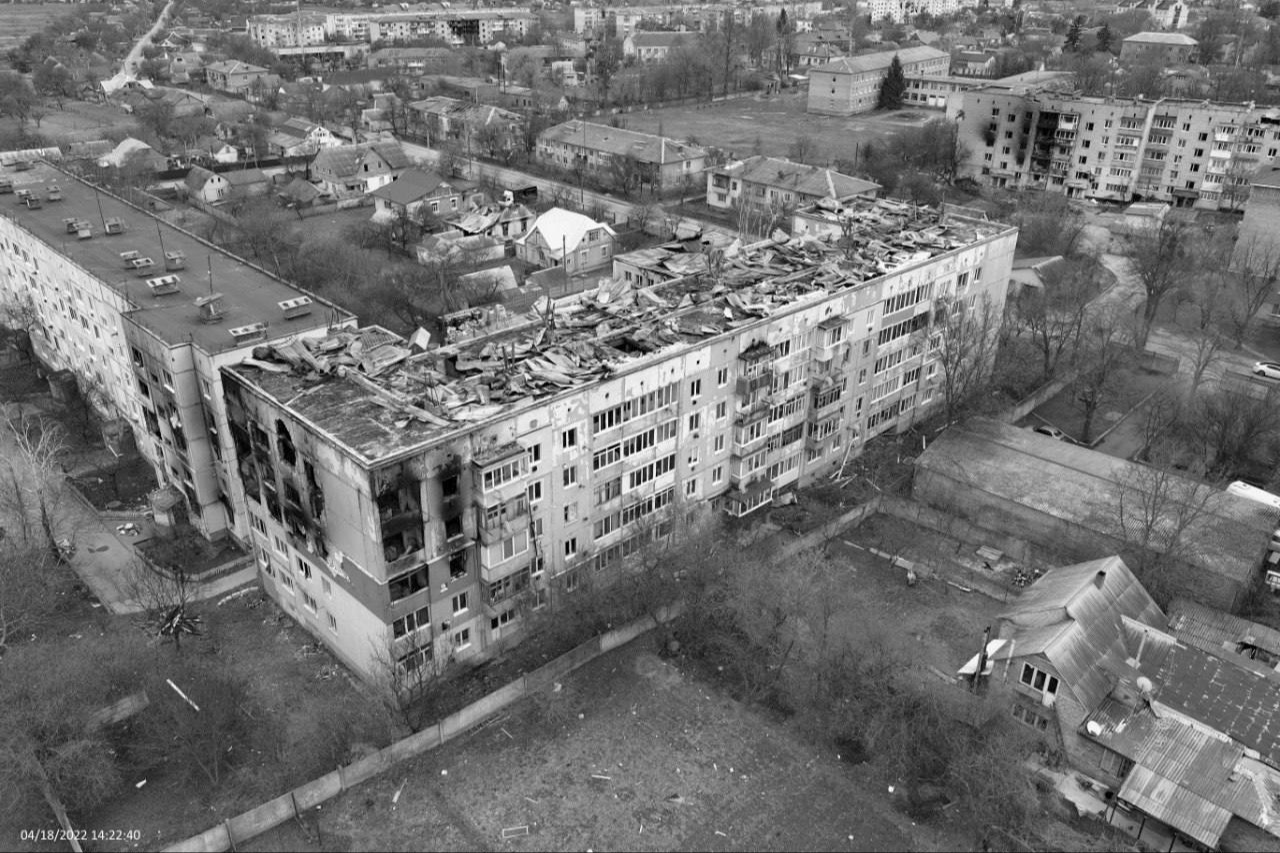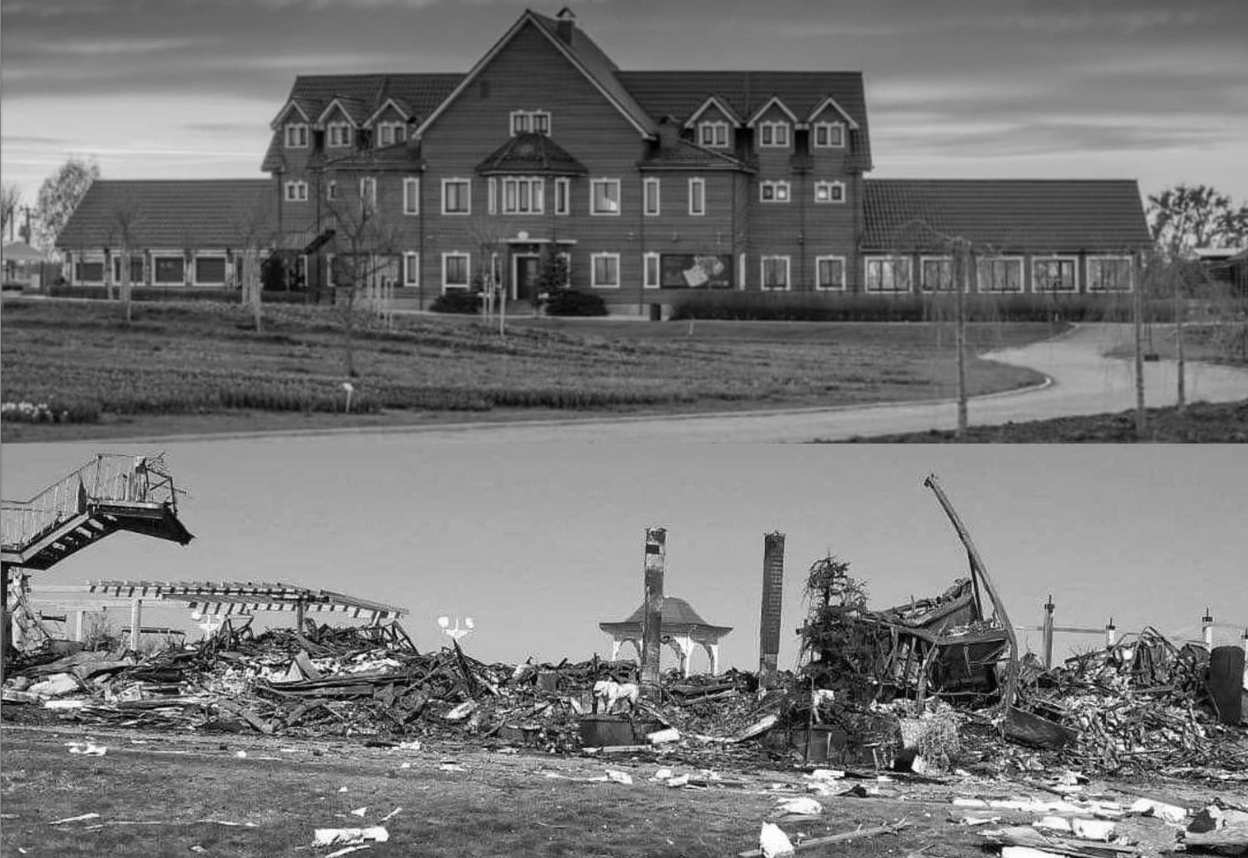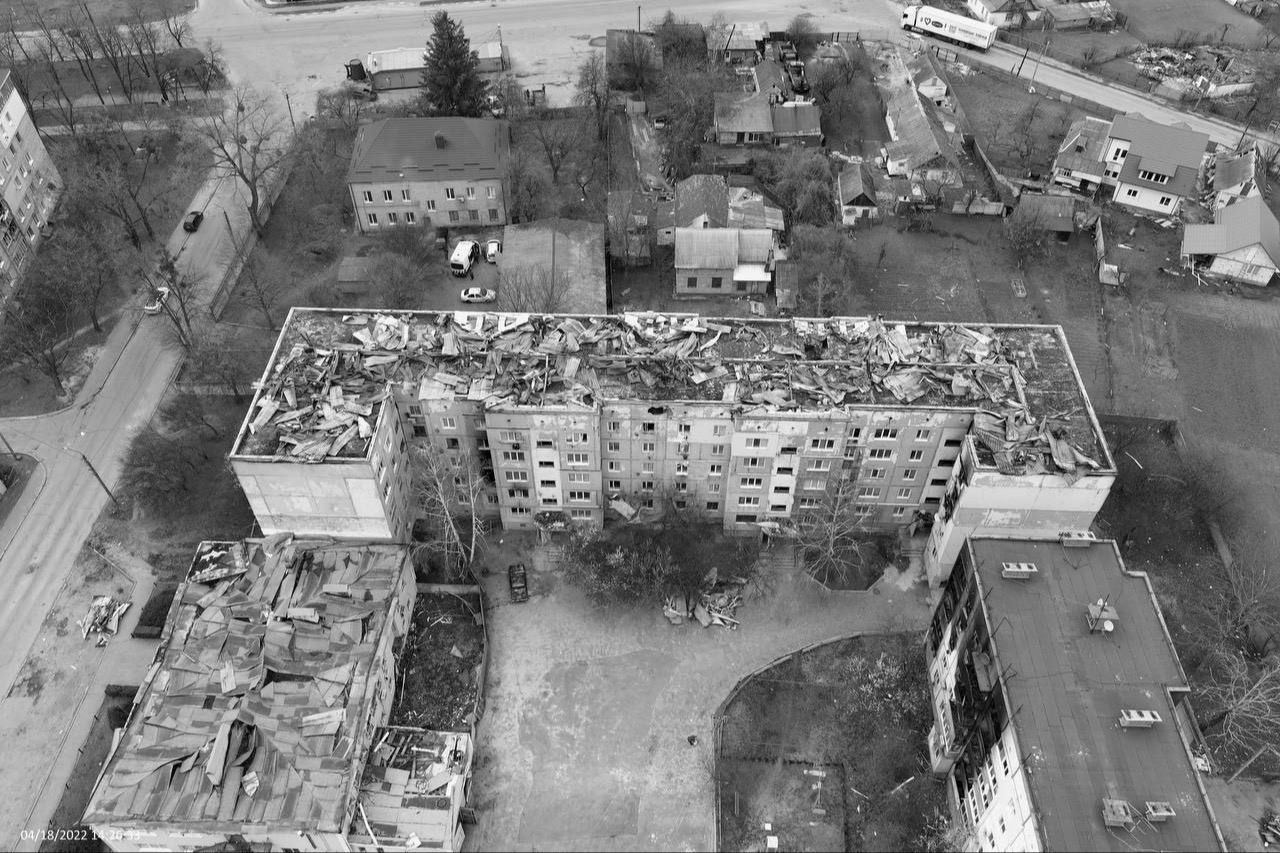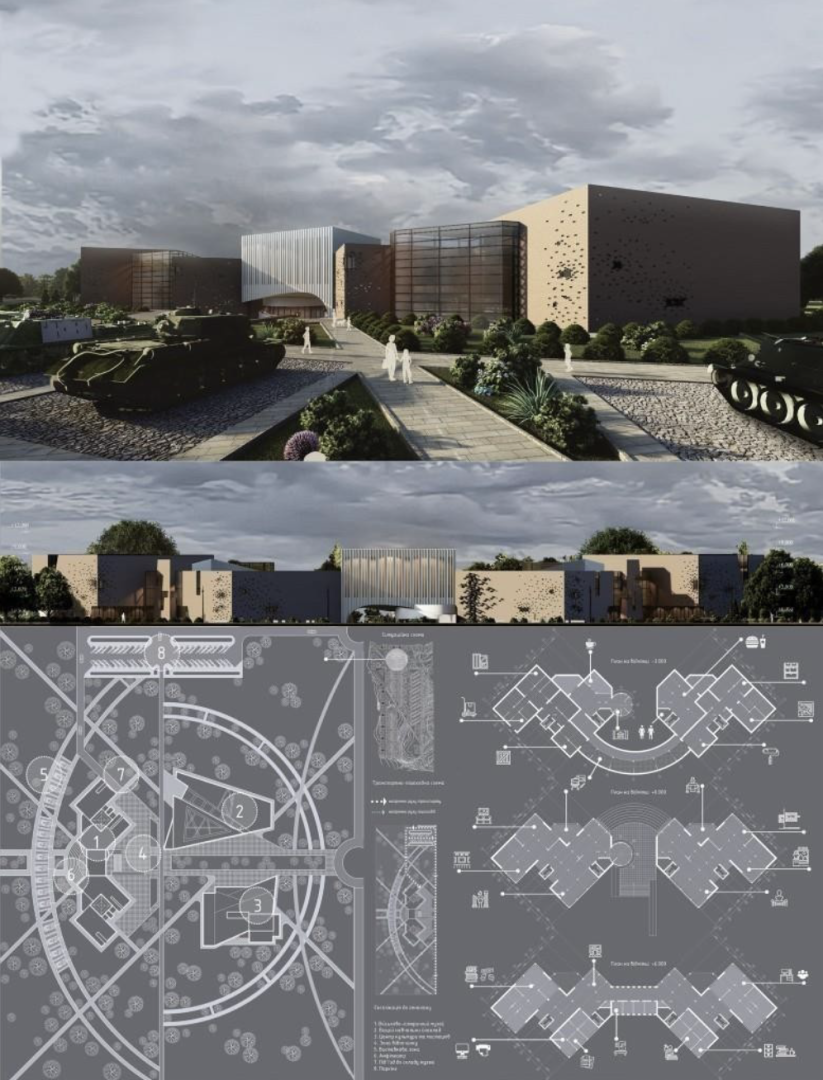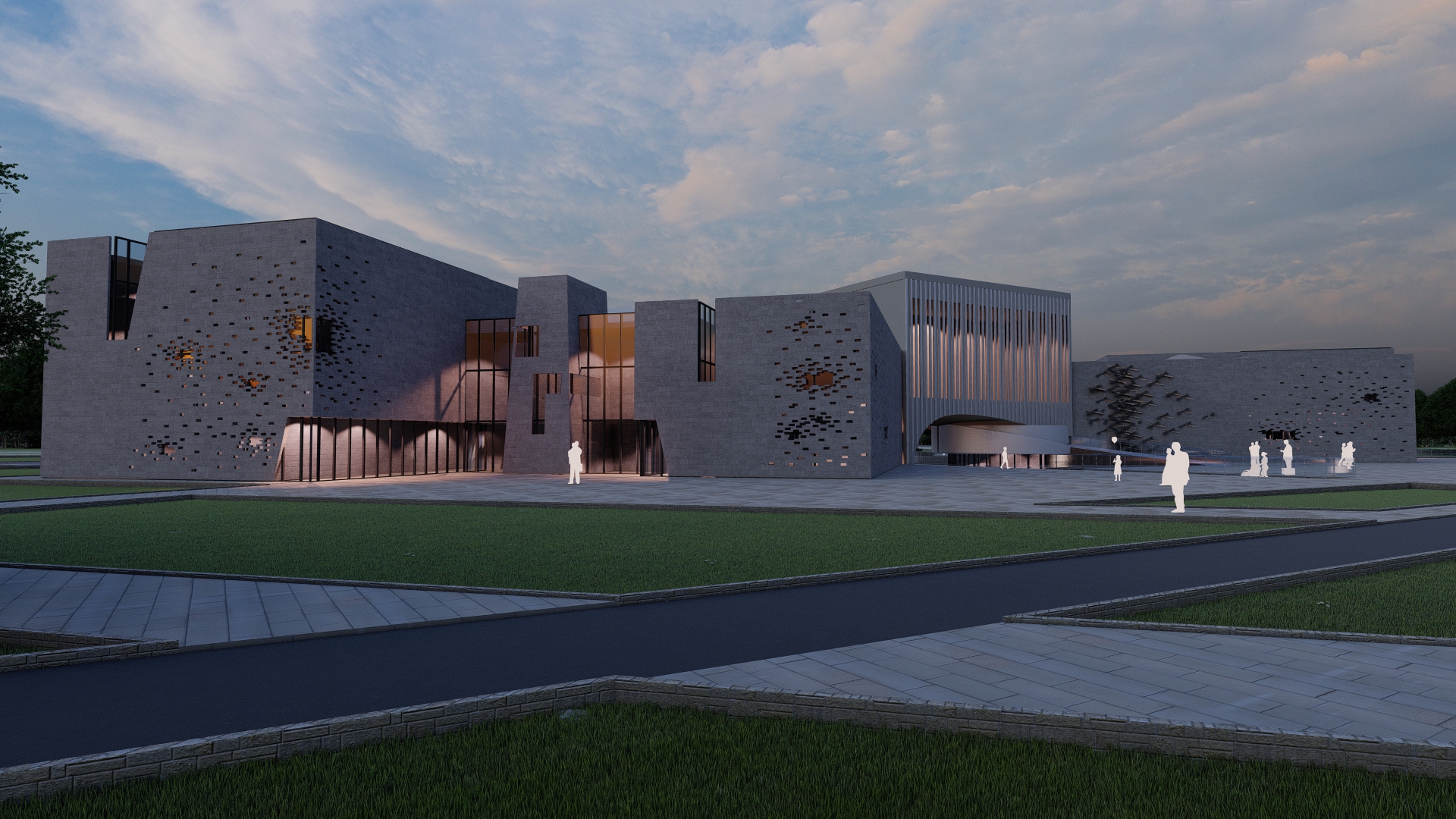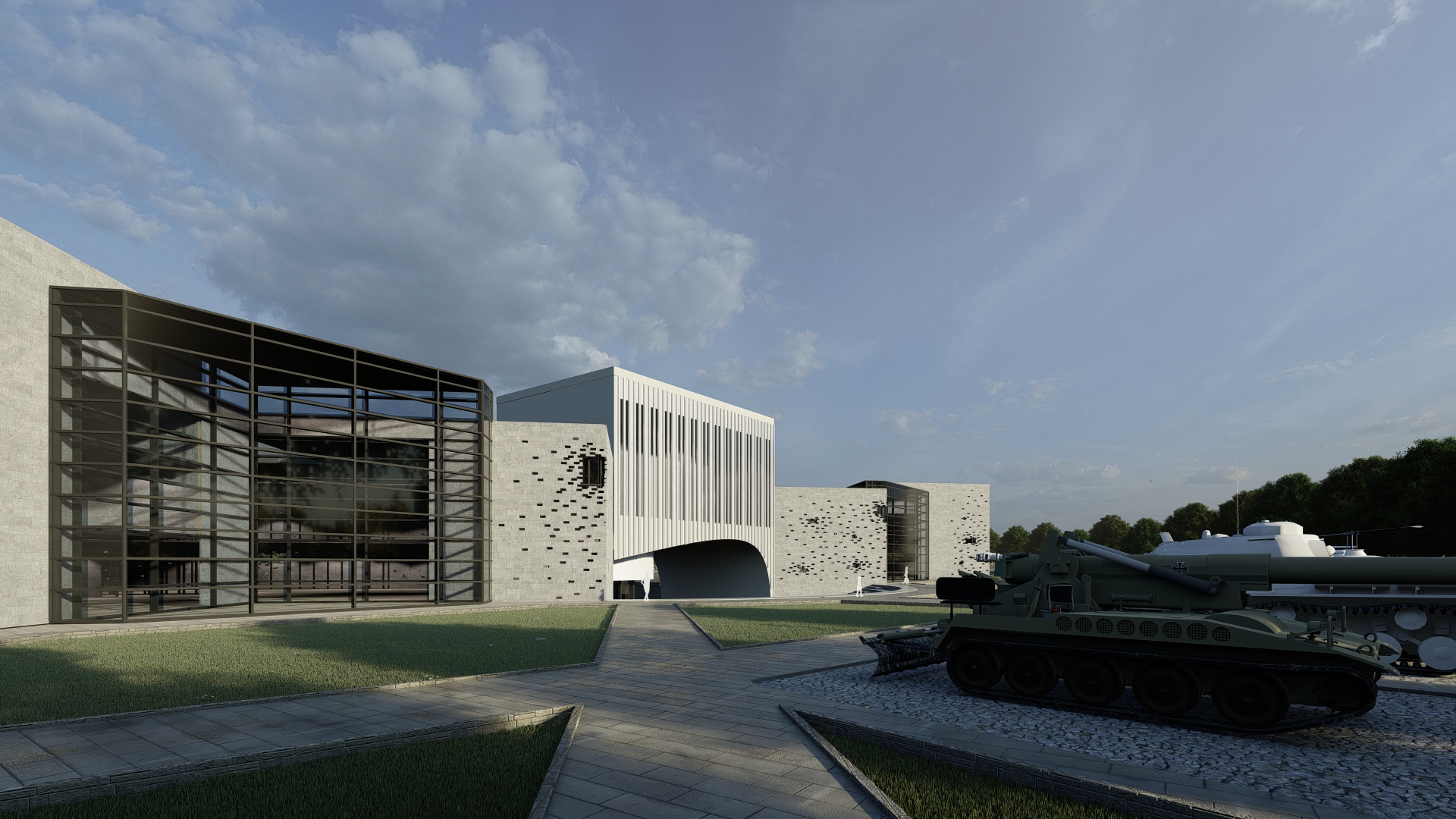Comprehensive Recovery for UKR cities
Basic information
Project Title
Comprehensive Recovery for UKR cities
Full project title
Comprehensive Recovery Program for Makariv Hromada (Municipality), Kyiv region
Category
Prioritising the places and people that need it the most
Project Description
We are rebuilding, renewing, and creating a beautiful, sustainable, prosperous future for building back better Ukraine. Our multidisciplinary urban recovery project aims at implementing comprehensive recovery programs and action plans based on the collection of an actual evidence databases, a holistic analysis of all areas of the municipality's life, building scenarios of potential ways of recovery and further development, and involving the community, local authorities and international experts.
Geographical Scope
Local
Project Region
Makariv and villages of Makariv Hromada (Munisipality), Kyiv Oblast (Region)., Ukraine
Urban or rural issues
It addresses urban-rural linkages
Physical or other transformations
It refers to a physical transformation of the built environment (hard investment)
EU Programme or fund
No
Description of the project
Summary
The project is an initiative to establish the methodology for comprehensive urban recovery and renewal of cities and Hromada (Municipality) in Ukraine, based on the international experience of cities post-war recovery and existing Ukrainian legislation. The project emphasizes sustainability, community engagement, and a holistic urban recovery and development approach. The project's primary goal is to plan the holistic restoration and development of Makariv Hromada (as a pilot) sustainably and inclusively, considering the principles and values of NEB. The project aims to engage the entire community by involving various stakeholders, including civil society institutions, local and central government authorities, businesses, international partners, and residents. Specific Objectives include prioritizing the recovery of critical urban infrastructure, exploring the possibilities for urban recovery during ongoing wartime, developing urban area plans and design prototypes for sustainable urban recovery, conducting research and analysis of existing conditions, and creating comprehensive recovery programs in line with international recommendations. The project completed its preparatory and investigation stage by establishing a local team, devising a methodology, identifying intervention areas through data analysis, creating development scenarios, formulating action plans, and promoting multi-stakeholder engagement while adhering to sustainable spatial development principles, European conventions, and legal acts. The project has the potential to be replicated in neighbouring cities in Ukraine. Its outcomes could serve as a model for post-conflict recovery and sustainable urban development in other regions. The project involves capacity building by working with local authorities and partners, creating a hub for discussions, fostering collaboration, and promoting knowledge transfer and capacity building.
Key objectives for sustainability
The key objectives of our project revolve around sustainability in several dimensions, including environmental, social, and economic aspects. These objectives have been met through a comprehensive and multi-stakeholder approach, making our project exemplary in promoting sustainable and complete recovery. Our project aimed to holistically develop principles, methods and methodology for the sustainable and comprehensive recovery of cities and municipalities (Makariv Hromada, as a pilot), focused on a long-term commitment to environmental recovery and empowering resilience. This includes developing sustainable urban area plans and design prototypes concentrating on energy efficiency, green spaces, and reducing the carbon footprint. In order to enhance sustainability, our project actively involves the community and various interest groups. Our project actively engages the local community and interest groups to strengthen social sustainability. This method encourages residents to take ownership, foster inclusivity and assume responsibility. The project also seeks to enhance the population's well-being by prioritizing the revitalisation of infrastructure and social services. A more socially resilient urban environment intends to be created by physically addressing the consequences of military aggression and involving the population in decision-making processes. The project highlights the significance of ensuring sustainability through establishing an industrial park that fosters the long-term growth of small and medium-sized businesses in the local community. It incorporates recovery initiatives and meticulously crafted action plans. The project promotes sustainability across various dimensions, and integrating NEB values emphasizes a holistic urban development perspective. The project demonstrates that we can create a more resilient urban environment by combining sustainability principles, community engagement, and a multidisciplinary approach.
Key objectives for aesthetics and quality
The key objectives of our project extend beyond the traditional aspects of urban development. Our approach aims to enhance the quality of life for people in post-war cities and municipalities by infusing elements of design and culture into the urban renewal process. The project embraces the principles of the NEB, emphasizing a holistic approach to design and aesthetics. The project has engaged architects and designers from the architecture faculty of NAU to create urban area plans and design prototypes of museums, new housing, and logistic centres that prioritize aesthetics while adhering to sustainable and cultural values. We have ensured that architectural and urban design and the overall visual appeal of the area. Cultural preservation and promotion are fundamental aspects of territorial recovery. Like all municipalities in Ukraine, Makariv Hromada has a rich cultural heritage affected by military aggression. To address this, the project seeks to restore and celebrate the region's cultural identity. This is achieved by integrating cultural elements into the design and urban development, including public art installations, cultural events, and the restoration and preservation of historical landmarks. It ensures that the local identity thrives in the renewed urban environment. Ultimately, our main objective is to improve and enrich the lives of the residents of Makariv and its neighbouring areas. We achieve this by integrating elements of beauty and cultural significance into the process of revitalizing our spaces. This approach helps create a more captivating environment for everyone involved. Our project showcases that urban renewal can go beyond functionality and practicality to prioritize beauty, culture, and human experience. By aligning with NEB principles, which emphasize integrating art, culture, and sustainability into urban development, our project can serve as a recovery model for other cities and regions.
Key objectives for inclusion
Our approach is dedicated to ensuring that the renewed urban environment is accessible and beneficial for all residents. The project provides urban revitalisation to every community member, including individuals with disabilities, military personnel, senior citizens and other marginalised groups. The project adheres to the principles of "design for all ", which means that the urban environment is created in a way that's easy to use and caters to people with diverse abilities. This involves creating accessible infrastructure, pathways, and public spaces, ensuring everyone can navigate and enjoy the urban environment without barriers, and building a rehabilitation centre for people with post-war trauma. We have incorporated measures to address affordability by developing a range of housing options, including housing units.
Additionally, economic revitalisation is a significant component of the project, focusing on creating job opportunities, developing the local businesses in innovative and logistic centres and industrial parks and fostering economic growth to ensure residents can afford to live and thrive in the renewed urban area. Decisions about urban development are made through multi-stakeholder engagement and participatory processes, ensuring that different voices are heard using City Labs. This inclusive approach fosters transparency and accountability, empowering the community to actively participate in shaping their future.
Additionally, economic revitalisation is a significant component of the project, focusing on creating job opportunities, developing the local businesses in innovative and logistic centres and industrial parks and fostering economic growth to ensure residents can afford to live and thrive in the renewed urban area. Decisions about urban development are made through multi-stakeholder engagement and participatory processes, ensuring that different voices are heard using City Labs. This inclusive approach fosters transparency and accountability, empowering the community to actively participate in shaping their future.
Results in relation to category
The project successfully created the methodology for developing Comprehensive recovery programs, based on existing Ukranian legislation and taking the aprouches and values from European. The project's design and planning incorporated principles of affordability and accessibility, ensuring that urban recovery and further development benefit all community segments, regardless of income or background. The project emphasized preserving cultural heritage and local aesthetics, enriching the cultural experience for residents and visitors. The improved urban environment created by the project can directly enhance the quality of life for people in Makariv (as a pilot) and the Hromada, contributing to their overall well-being. The project engaged various stakeholders, building their capacity to contribute to sustainable urban development and post-conflict recovery. The project's outcomes and methodologies offer a replicable model for neighbouring cities and regions, facilitating knowledge transfer and best practices. The project's focus on sustainability, both in environmental and community terms, aligns with the New European Bauhaus principles. The project's multi-dimensional approach to urban development embodies the holistic perspective of the NEB. The active involvement of stakeholders had a direct impact on project decisions, ensuring that the community's needs and views were considered. The project's outcomes have positively and transformatively impacted Makariv and its Hromada, serving as an exemplary model for sustainable urban development and post-conflict recovery of other cities and municipalities in Ukraine.
How Citizens benefit
The communication project plan organizes community events, workshops, City Labs and activation programs, encouraging residents to be involved in recovery at all stages. This approach enhances community cohesion, as residents feel a deeper connection to the renewed urban environment. Citizens and civil society have played a central role in our project, contributing to its success by actively participating in various aspects of the initiative. Defined stakeholders formed in working groups were engaged in the early stages of project planning and design. They participated in meetings where they provided valuable input on the aesthetics and functionality of urban renewal. Their input helped shape the project's design, ensuring that it aligns with local cultural preferences, values, and quality-of-life expectations. The project has benefited from local insights, leading to a higher quality of design and execution.
Physical or other transformations
It refers to a physical transformation of the built environment (hard investment)
Innovative character
The project adopts a holistic approach and simultaneously addresses environmental, social, and economic sustainability. Such a comprehensive strategy is innovative and aligns with the New European Bauhaus principles. Instead of top-down decision-making, the project actively involves residents and civil society institutions in shaping the project's direction. It allows the municipality not to wait for recovery documents for the region but to contribute with a locally developed one. This method gives power to the community and encourages a feeling of ownership and accountability. The project relies on data-driven decision-making to understand existing conditions, track progress, and adapt strategies, ensuring the most efficient use of resources. This project excels in simultaneously addressing environmental, economic, and social sustainability. It complies with European conventions and legal acts related to urban development and existing Ukrainian legislation, setting a high standard for sustainable urban recovery. The potential for replication in neighbouring cities in Ukraine and other post-conflict regions makes this project innovative. It is an exemplary sustainable urban development and recovery model, setting a benchmark for future initiatives. The project's emphasis on long-term resilience in infrastructure and community well-being is an innovative approach to planning the recovery of Ukrainian cities and municipalities. These methods prepare the community to withstand future challenges, ensuring a sustainable and resilient future. The engagement of stakeholders at various levels ensures alignment with regional and national strategies while fostering international cooperation, which is not always a common practice in local urban development projects in Ukraine.
Disciplines/knowledge reflected
The interaction of representatives from diverse disciplines and knowledge fields added depth and breadth to the project, resulting in a holistic, sustainable, and exemplary urban recovery and development initiative. The interaction of diverse fields led to innovative solutions and fresh ideas, resulting in a well-rounded project design. Representatives from different disciplines comprehensively understood the project's complex challenges, enhancing decision-making. The project's layout was developed with input from planning and architecture experts and engineers who are members of the NSAU to ensure that the urban spaces created were both sustainable and visually appealing. Their expertise contributed to the project's architectural and urban design excellence, optimizing land use and infrastructure planning. The academic research institution NAU analyzed existing conditions and collected data for evidence-based planning. Their role provided valuable insights into the project's progress and helped fine-tune strategies. The project achieved holistic sustainability planning by incorporating environmental, economic, and social expertise, ensuring it was environmentally responsible, economically viable, and socially inclusive. The collaborative nature of the project fostered knowledge exchange, breaking down silos and facilitating informed decision-making. The engagement of various disciplines ensured that no aspect of sustainability, design, or community engagement was overlooked, contributing to the project's exemplary status.
Methodology used
The project follows a well-structured methodology encompassing three stages:
1. Preparatory and Research Stage: Establishing a local team. Developing a communication strategy. Determining the participation of all interested parties, including the public. Launching the process. Data collection and analysis to understand the existing conditions. This stage involves an in-depth analysis of different thematic layers of collected data, such as social infrastructure, commercial and economic aspects, and critical infrastructure. This analysis helps identify potential areas for intervention and the risks and opportunities for the region.
2. Scenarios Building and Action Planning: Creating possible future development scenarios based on the analysis, developing action and implementation plans, and conducting public discussions and engagement events. This stage allows the project to build a vision for the future based on data-driven scenarios. It includes active participation and engagement of various stakeholders, promoting multi-stakeholder collaboration and participatory decision-making.
3. Implementation Stage: Prioritizing project implementation with a technical and economic rationale. Development of an action plan with a detailed description of required resources and funding. This approach ensures that the community actively shapes the project's direction, fostering inclusive governance and a sense of ownership. The project also emphasizes the need for transparent project management mechanisms, including financial, governance, coordination, and consultation mechanisms. Project management monitoring and assessment of territory development indicators by the advisory team, including Ukrainian and international experts, is crucial at all project stages. The project's approach consists of a gradual, purposeful, and adaptable process, focusing on recovery, improvement, and long-term development. It also emphasizes capacity-building knowledge transfer.
1. Preparatory and Research Stage: Establishing a local team. Developing a communication strategy. Determining the participation of all interested parties, including the public. Launching the process. Data collection and analysis to understand the existing conditions. This stage involves an in-depth analysis of different thematic layers of collected data, such as social infrastructure, commercial and economic aspects, and critical infrastructure. This analysis helps identify potential areas for intervention and the risks and opportunities for the region.
2. Scenarios Building and Action Planning: Creating possible future development scenarios based on the analysis, developing action and implementation plans, and conducting public discussions and engagement events. This stage allows the project to build a vision for the future based on data-driven scenarios. It includes active participation and engagement of various stakeholders, promoting multi-stakeholder collaboration and participatory decision-making.
3. Implementation Stage: Prioritizing project implementation with a technical and economic rationale. Development of an action plan with a detailed description of required resources and funding. This approach ensures that the community actively shapes the project's direction, fostering inclusive governance and a sense of ownership. The project also emphasizes the need for transparent project management mechanisms, including financial, governance, coordination, and consultation mechanisms. Project management monitoring and assessment of territory development indicators by the advisory team, including Ukrainian and international experts, is crucial at all project stages. The project's approach consists of a gradual, purposeful, and adaptable process, focusing on recovery, improvement, and long-term development. It also emphasizes capacity-building knowledge transfer.
How stakeholders are engaged
Local Stakeholders were actively engaged, including residents, local self-government, and local businesses. They provided insights into the unique needs and preferences of the community. They played a central role in decision-making processes, including shaping the project's design and priorities. Involving local stakeholders ensured the project was tailored to meet the community's specific needs. Regional government authorities and relevant regional organizations were involved. They provided necessary permits and compliance support. Regional stakeholders facilitated the alignment of the project with broader regional development strategies, ensuring its integration into the regional context. National stakeholders' companies of NGO the National Union of Architects of Ukraine (NSAU) and Academia: National Aviation University, Architecture Faculty (NAU). They provided the necessary technical support and expertise. They were consulted to navigate regulatory requirements and secure funding. National stakeholders ensured the project complied with legal and regulatory standards. European-level organizations - Drees&Sommer (D&S) aligned the project with European conventions and sustainability standards. European stakeholders helped the project adhere to higher sustainability standards and promoted knowledge exchange at the European level.
Global challenges
The key elements of your project could be replicated or transferred to others:
1. Addressing Conflict and Post-Conflict Recovery: This project provides a localized solution to the global challenge of recovering after conflicts in areas impacted by aggression. Focusing on restoring infrastructure, housing, and the local economy contributes to the broader objective of rebuilding societies in conflict-affected regions. This effort aims to promote stability and prevent displacement.
2. Promoting Community Engagement: The project actively encourages community involvement and inclusive decision-making. This grassroots approach aligns to foster participatory governance, strengthening social cohesion and empowering communities in shaping their futures through decision-making processes.
3. Knowledge Transfer: The project's focus on capacity building, knowledge transfer, and the involvement of stakeholders from various disciplines contributes to addressing global challenges related to knowledge sharing, collaboration, and capacity building.
4. Scaling and replication: The ability to replicate and scale the project shows how solutions implemented at the munisipality or city level can be expanded to tackle more significant issues in urban development, and sustainability. These local initiatives align with promoting global peace, sustainability and fair development.
1. Addressing Conflict and Post-Conflict Recovery: This project provides a localized solution to the global challenge of recovering after conflicts in areas impacted by aggression. Focusing on restoring infrastructure, housing, and the local economy contributes to the broader objective of rebuilding societies in conflict-affected regions. This effort aims to promote stability and prevent displacement.
2. Promoting Community Engagement: The project actively encourages community involvement and inclusive decision-making. This grassroots approach aligns to foster participatory governance, strengthening social cohesion and empowering communities in shaping their futures through decision-making processes.
3. Knowledge Transfer: The project's focus on capacity building, knowledge transfer, and the involvement of stakeholders from various disciplines contributes to addressing global challenges related to knowledge sharing, collaboration, and capacity building.
4. Scaling and replication: The ability to replicate and scale the project shows how solutions implemented at the munisipality or city level can be expanded to tackle more significant issues in urban development, and sustainability. These local initiatives align with promoting global peace, sustainability and fair development.
Learning transferred to other parties
The comprehensive three-stage methodology developed for this project, which includes preparatory and research work, scenario building and action planning, and implementation, can be applied to other regions and municipalities facing similar challenges, especially those affected by conflict or disasters. This project creates a structured approach to urban recovery and develops that payment is adaptable to different contexts. A data-driven approach to collecting and analyzing information from social infrastructure, commerce, and critical infrastructure can provide a valuable model for making evidence-based decisions in other recovery projects. It can be applied in post-war development scenarios building. An important aspect involves a range of stakeholders, including local government officials, community organizations, businesses and the general public, in the decision-making process and scenario planning through City Labs. This inclusive approach can be replicated in different contexts as well. It promotes inclusive governance and community engagement, which can be adopted in other urban development initiatives. The project's interdisciplinary approach, involving various fields such as academia, professional practice, government, and the private sector, can be transferred to other projects. Collaboration among diverse disciplines can lead to innovative, holistic urban recovery and development solutions. As a regional project, the outcomes and methodologies developed can be scaled and applied to neighbouring cities and regions in Ukraine. The success and impact of this project can serve as a model for post-conflict recovery and sustainable urban development.
Keywords
Comprehensive Recovery Program
Post-War Reconstruction
Multidisciplinary Approach
Community Engagement
Ukraine's Sustainable Development

